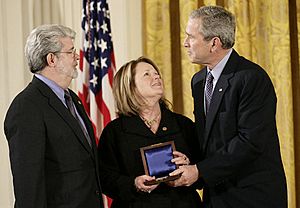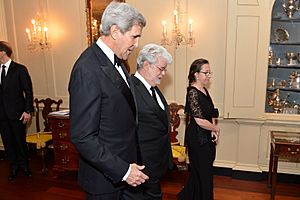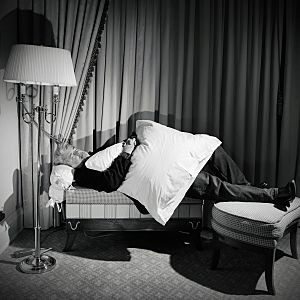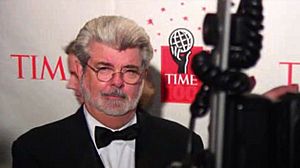George Lucas facts for kids
Quick facts for kids
George Lucas
|
|
|---|---|

Lucas in 2024
|
|
| Born |
George Walton Lucas Jr.
May 14, 1944 Modesto, California, U.S.
|
| Education |
|
| Occupation |
|
| Years active | 1965–present |
|
Works
|
Full list |
| Spouse(s) |
|
| Children | 4, including Amanda and Katie |
George Walton Lucas Jr. (born May 14, 1944) is an American filmmaker and generous giver. He is famous for creating the Star Wars and Indiana Jones movie series. He also started important companies like Lucasfilm, LucasArts, Industrial Light & Magic, and THX. George Lucas led Lucasfilm for many years before selling it to the Walt Disney Company in 2012. He is seen as a very important person in the "New Hollywood" film movement of the 20th century. He also helped create the idea of modern blockbuster movies. Since 2015, he has mostly stepped back from making films to focus on other projects.
After finishing college at the University of Southern California in 1967, Lucas moved to San Francisco. There, he started a film studio called American Zoetrope with director Francis Ford Coppola. Lucas wrote and directed THX 1138 (1971), which was based on a short film he made in college. This movie was liked by critics but did not make much money. His next film, American Graffiti (1973), was inspired by his own teenage years. This movie was a big success with both critics and audiences. It also earned five Academy Award nominations.
Lucas's next film was the huge space opera Star Wars (1977). This movie, later called A New Hope, had a difficult time being made. However, it became a massive hit and the highest-earning film of its time. Star Wars won six Academy Awards and started a huge cultural phenomenon. Lucas then produced and helped write the sequels: The Empire Strikes Back (1980) and Return of the Jedi (1983). He also worked with director Steven Spielberg to create the Indiana Jones movies. These include Raiders of the Lost Ark (1981) and The Last Crusade (1989).
In 1997, Lucas re-released the original Star Wars movies with new special effects. He then returned to directing with the Star Wars prequel movies. These were The Phantom Menace (1999), Attack of the Clones (2002), and Revenge of the Sith (2005). Lucas also worked on the animated Star Wars: The Clone Wars series. He is known for working with composer John Williams, who created the famous music for his films.
Lucas is one of the most successful filmmakers in history when it comes to money. His companies, Industrial Light and Magic and Skywalker Sound, helped make many big movies. Besides filmmaking, Lucas has given a lot of money to support education and the arts. He started the George Lucas Educational Foundation. He also developed the Lucas Museum of Narrative Art in Los Angeles with his wife, Mellody Hobson.
Early Life and Education
George Lucas was born and grew up in Modesto, California. His parents were Dorothy and George Walton Lucas Sr. He enjoyed comics and science fiction, especially TV shows like the Flash Gordon serials.
Before he became a filmmaker, Lucas dreamed of being a racecar driver. He spent his high school years racing cars and hanging out at garages. In 1962, just before he graduated, Lucas was in a serious car accident. His car crashed into a tree, but he was thrown from the car and survived. This accident made him lose interest in racing. Instead, it inspired him to follow his other passions.
Lucas's father wanted him to work in the family stationery store. But Lucas wanted to go to art school. He attended Modesto Junior College, where he studied subjects like anthropology and literature. He also started filming car races with an 8-millimeter camera. During this time, Lucas became interested in underground and avant-garde films. He also watched classic European movies with his friend John Plummer.
Plummer suggested that Lucas transfer to the University of Southern California (U.S.C.) School of Cinematic Arts. U.S.C. was one of the first universities to have a film school. At U.S.C., Lucas became friends with other talented film students. This group included Steven Spielberg and Martin Scorsese.
Lucas was greatly influenced by a course called Filmic Expression. This class focused on how film uses color, light, and movement to create feelings. Another important influence was Slavko Vorkapich, who taught about the power of cinematic art.
After graduating in 1967, Lucas tried to join the United States Air Force. He was turned down because of too many speeding tickets. He was later called to serve in the Vietnam War. However, he was excused from service because he had diabetes.
Film Career
Early Filmmaking (1965–1969)
In college, Lucas watched many inspiring films, especially visual films from Canada. He loved making short films that focused on visuals and emotions, not just stories. He was very interested in cinematography (how films are shot) and editing. He saw himself as a filmmaker who created abstract visual experiences.
In 1967, Lucas went back to U.S.C. for graduate studies. He worked for the United States Information Agency, where he met his future wife, Marcia Griffin. Lucas directed a short film called Electronic Labyrinth: THX 1138 4EB. This film won first prize at a student film festival. Lucas also got a scholarship from Warner Bros. to watch a film being made. He chose Finian's Rainbow (1968), directed by Francis Ford Coppola. In 1969, Lucas was one of the camera operators for the Rolling Stones concert film Gimme Shelter.
Creating THX 1138, American Graffiti, and Star Wars (1969–1977)
In 1969, Lucas moved back to the San Francisco Bay Area. He and Coppola started American Zoetrope. They hoped to make films freely, away from Hollywood's strict rules. Coppola thought Lucas's short film Electronic Labyrinth could become a full movie. This led to THX 1138, but it was not a success. Lucas then started his own company, Lucasfilm, Ltd., and directed the very successful American Graffiti (1973).
Next, Lucas wanted to make a movie based on Flash Gordon, an adventure serial he loved as a child. When he could not get the rights, he decided to write his own space adventure. This became Star Wars. Even after the success of American Graffiti, almost every studio turned Star Wars down. Only Alan Ladd Jr. at 20th Century Fox agreed to make it. Star Wars was greatly influenced by samurai films and Spaghetti Westerns.
Star Wars quickly became the highest-earning film of all time. It was later surpassed by Spielberg's E.T. the Extra-Terrestrial. Before filming Star Wars, Lucas chose to keep the rights to merchandise and sequels instead of a higher upfront fee. This decision made Lucasfilm hundreds of millions of dollars from toys and games.
Making the first Star Wars film was very difficult. During editing, Lucas suffered from stress and exhaustion. The hard work on Star Wars and its sequels also put a strain on his marriage. The film's success brought Lucas fame and wealth, but also unwanted attention.
Break from Directing and Indiana Jones (1977–1993)

After Star Wars, Lucas spent a lot of time as a writer and producer. He worked on many Star Wars spin-offs for film and TV. He was the executive producer for The Empire Strikes Back and Return of the Jedi. He also helped write these films. Lucas also wrote the stories and was executive producer for the first four Indiana Jones movies. His good friend Steven Spielberg directed these films.
Lucas was also an executive producer for other movies during this time. These included Jim Henson's Labyrinth (1986) and Ron Howard's Willow (1988). However, some projects were not successful, like Howard the Duck (1986).
The animation studio Pixar was first part of Lucasfilm's computer division. In 1986, Steve Jobs bought Pixar from Lucas. This sale helped Lucas focus his company on making entertainment, not just new technology tools.
In 1983, Lucas and Tomlinson Holman started the audio company THX. This company creates high-quality sound systems for films and music. Skywalker Sound handles sound effects, and Industrial Light & Magic creates visual effects for Lucasfilm. Lucasfilm Games, later called LucasArts, makes video games.
Directing Again: Star Wars and Indiana Jones (1993–2012)

By 1993, Lucas announced he would make the Star Wars prequels. He wanted to tell the tragic story of Anakin Skywalker becoming Darth Vader. He also decided that the prequels would be the beginning of one long story, making the films a "Saga." In 1994, Lucas started writing the first prequel, Episode I: The Beginning.
In 1997, to celebrate 20 years of Star Wars, Lucas re-released the original movies. He used new digital technology to update them. These "Special Editions" were shown in theaters. The films were updated again for DVD, Blu-ray, and 4K releases.
The first Star Wars prequel, Episode I – The Phantom Menace, was released in 1999. This was the first film Lucas had directed in over 20 years. He then directed the next two prequels: Attack of the Clones (2002) and Episode III – Revenge of the Sith (2005). Many older fans and critics had mixed feelings about the prequels. However, they were very popular with younger fans and made a lot of money.
Lucas also worked as a writer for the 2008 film Indiana Jones and the Kingdom of the Crystal Skull, directed by Steven Spielberg. Like the Star Wars prequels, this film received mixed reactions. From 2008 to 2014, Lucas was the creator and executive producer for the animated series Star Wars: The Clone Wars. This series filled in the story between Attack of the Clones and Revenge of the Sith.
In 2012, Lucas helped fund and was executive producer for Red Tails. This war film was about the Tuskegee Airmen during World War II.
Semi-Retirement (2012–Present)
In January 2012, Lucas announced he was stepping back from making big blockbuster films. He wanted to focus on smaller, independent movies.
In June 2012, Kathleen Kennedy became co-chair of Lucasfilm Ltd. She was a long-time collaborator with Steven Spielberg. Lucas remained chief executive for a year, and then Kennedy took over. When Lucasfilm was sold to Disney, Lucas became Disney's second-largest single shareholder.
Lucas was a creative consultant for the first film in the Star Wars sequel trilogy, The Force Awakens. He attended early story meetings and shared his knowledge of the Star Wars universe. However, Disney decided not to use his story ideas for the new trilogy.

The Force Awakens, directed by J. J. Abrams, was released on December 18, 2015. Kathleen Kennedy produced this film and its sequels. The new sequel trilogy was made by Lucasfilm and The Walt Disney Company. Lucas later said that selling Lucasfilm to Disney was like a divorce. He also mentioned creative differences with the producers of The Force Awakens. Lucas described the first six Star Wars films as his "children" and defended his vision for them.
In 2015, Lucas wrote the animated film Strange Magic, his first musical. This film was made at Skywalker Ranch. A fifth Indiana Jones movie was also planned. Lucas was credited as an executive producer for this film. In 2016, Rogue One: A Star Wars Story was released. This film told the story of how the plans for the Death Star were stolen. Lucas reportedly liked it more than The Force Awakens. The Last Jedi, the second film in the sequel trilogy, was released in 2017. Lucas called the film "beautifully made."
Lucas had some involvement with Solo: A Star Wars Story (2018) and The Mandalorian streaming series. He also met with J. J. Abrams before the final sequel trilogy film, The Rise of Skywalker, was written. This film was released in 2019.
Other Ventures
Lucasfilm
Lucas founded his film production company, Lucasfilm, in 1971. It became Lucasfilm Ltd. in 1977. In the 1970s, the company's offices were at Universal Studios Lot. Lucas also started the Star Wars Corporation, Inc. This company handled the legal and financial parts of Star Wars, including copyright and rights for sequels and merchandise.
Industrial Light & Magic (ILM)
Lucas founded Industrial Light & Magic (ILM) in 1975. He wanted his 1977 film Star Wars to have visual effects never seen before. When he found out that 20th Century Fox's effects department was closed, Lucas looked for other options. He approached Douglas Trumbull, known for effects in 2001: A Space Odyssey. Trumbull was busy, but he suggested his assistant, John Dykstra. Dykstra gathered a small team of students, artists, and engineers. They set up in a warehouse in Van Nuys, California. Lucas named the group Industrial Light and Magic, and it became the Special Visual Effects department for Star Wars.
Lucas Museum of Narrative Art
By 2013, Lucas was thinking about building a museum. It would be called the Lucas Cultural Arts Museum. It would display his collection of illustrations and pop art. Lucas offered to pay for the museum's construction and provide money for its future. After not reaching an agreement in San Francisco, Lucas looked at Chicago.
The museum project was renamed the Lucas Museum of Narrative Art. In 2016, Lucas decided not to build the museum in Chicago due to a lawsuit. On January 17, 2017, Lucas announced that the museum would be built in Exposition Park, Los Angeles, California. It is expected to be finished in 2026.
Collaborations
Lucas was very involved in the music for the original Star Wars soundtrack. John Williams composed the music, recommended by Steven Spielberg. Williams suggested using recurring musical themes (called leitmotifs) to make the story better. This was inspired by classical composers. The film and its sequels use themes like the Main Title Theme and the Force Theme.
The music was highly praised and won Williams an Academy Award for Best Original Score. The American Film Institute named it the greatest film score of all time in 2005. Lucas and Williams continued to work together on all the Star Wars and Indiana Jones films. Lucas has often said that Williams is the "secret sauce" of his movies.
Philanthropy
George Lucas is one of the wealthiest film celebrities in the world. He has promised to give half of his money to charity. This is part of an effort called The Giving Pledge, started by Bill Gates and Warren Buffett.
George Lucas Educational Foundation
In 1991, The George Lucas Educational Foundation was started. It is a nonprofit organization that supports new ideas in schools. The foundation's work is shared through Edutopia, a website, social media, and documentary films. Lucas, through his foundation, strongly supported the E-Rate program. This program helps provide internet funding to schools and libraries.
Proceeds from Lucasfilm Sale
In 2012, Lucas sold Lucasfilm to The Walt Disney Company for about $4.05 billion. It was widely reported that Lucas planned to give most of this money to charity. A spokesperson for Lucasfilm said Lucas intended to donate the majority of the money to his charity work. Lucas himself said he was happy to devote more time and money to helping others.
Other Initiatives
In 2005, Lucas gave $1 million to help build the Martin Luther King Jr. Memorial in Washington, D.C.
In 2006, the University of Southern California announced that Lucas had donated $175–180 million to his old film school. This was the largest single donation to U.S.C. and the largest gift ever to a film school.
In 2013, Lucas and his wife Mellody Hobson donated $25 million to After School Matters. This is a Chicago-based nonprofit that provides programs for teenagers.
In 2021, Lucas and his wife made a donation to New York University (NYU). This donation helped create the Martin Scorsese Institute of Global Cinematic Arts.
Personal Life
In 1969, Lucas married film editor Marcia Lou Griffin. She won an Academy Award for editing the original Star Wars film. They adopted a daughter, Amanda Lucas, in 1981. They divorced in 1983. Lucas later adopted two more children as a single parent: daughter Katie Lucas, born in 1988, and son Jett Lucas, born in 1993. His three oldest children appeared in the Star Wars prequels.
Lucas started dating Mellody Hobson in 2006. She is a successful businesswoman. They announced their engagement in January 2013 and married on June 22, 2013. They have one daughter together, born in August 2013.
Lucas was raised in a Methodist family. The religious and mythical ideas in Star Wars were inspired by his interest in the writings of mythologist Joseph Campbell. Lucas has said his religion is "Buddhist Methodist." He lives in Marin County.
Lucas is a big collector of art by the American illustrator Norman Rockwell. A collection of Rockwell's paintings owned by Lucas and Steven Spielberg was shown at the Smithsonian American Art Museum.
Lucas is a fan of the TV show Family Guy. The show has even made parodies of his Star Wars films.
Filmography
| Year | Title | Distributor |
|---|---|---|
| 1971 | THX 1138 | Warner Bros. |
| 1973 | American Graffiti | Universal Pictures |
| 1977 | Star Wars | 20th Century Fox |
| 1999 | Star Wars: Episode I – The Phantom Menace | |
| 2002 | Star Wars: Episode II – Attack of the Clones | |
| 2005 | Star Wars: Episode III – Revenge of the Sith |
Awards and Honors
In 1977, Lucas received the Inkpot Award.
The American Film Institute gave Lucas its Life Achievement Award on June 9, 2005. This was shortly after Star Wars: Episode III – Revenge of the Sith was released. Lucas joked that since he saw the whole Star Wars series as one film, he could finally get the award now that he had "finished the movie."
Lucas was nominated for four Academy Awards for his directing and writing. He received the academy's Irving G. Thalberg Award in 1991. In 2007, he appeared at the Academy Awards with Steven Spielberg and Francis Ford Coppola. They presented the Best Director award to their friend Martin Scorsese.
The Science Fiction Hall of Fame welcomed Lucas in 2006. The Discovery Channel named him one of the 100 "Greatest Americans" in 2008. In July 2013, President Barack Obama gave Lucas the National Medal of Arts for his work in American cinema.
In August 2015, Lucas was named a Disney Legend. On December 6, 2015, he was honored at the Kennedy Center Honors. In May 2024, Lucas received the Honorary Palme d'Or at the Cannes Film Festival. This is one of the highest honors in the film industry.
|
See also
 In Spanish: George Lucas para niños
In Spanish: George Lucas para niños





